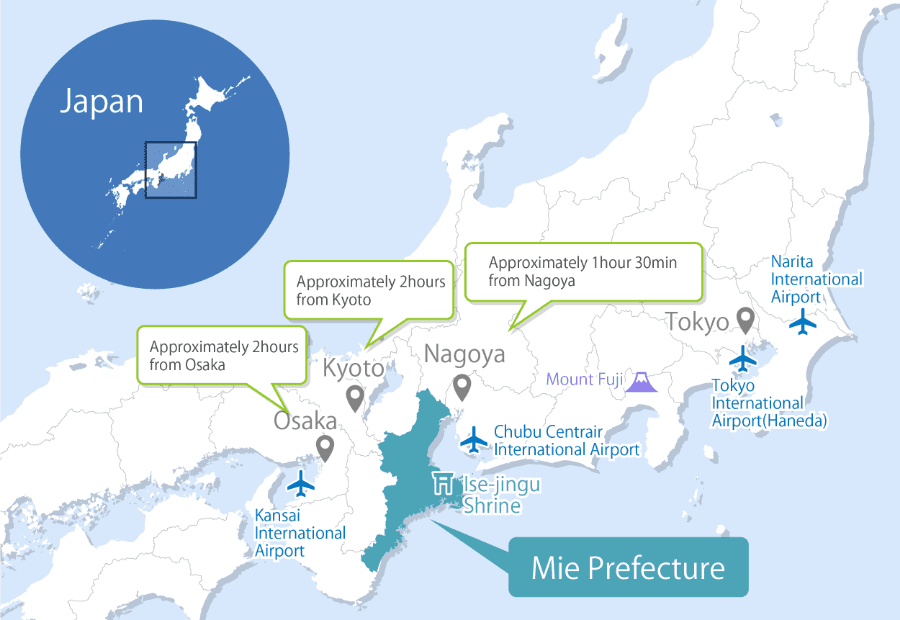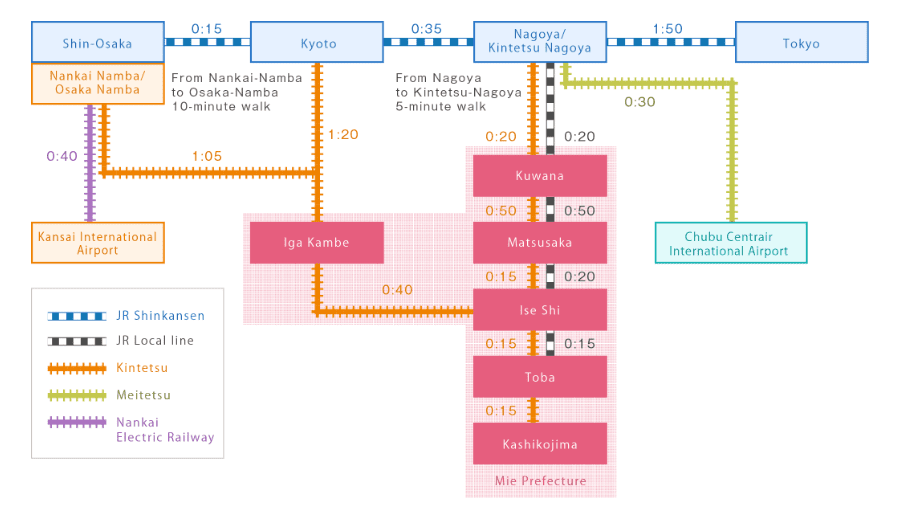Access / Q & A
How to Get to Ise Shima
The base of the Ise / Shima journey is Ise-shi station, which is the nearest station to Ise Jingu.
I recommend the luxurious 「Kanko Express Shimakaze*」and ferries that give a taste of a cruise, Both are transportation methods that are enjoyable themselves!
*Can be boarded from Osaka Namba, Kyoto and Kintetsu Nagoya.


【First Worship / Ise Jingu Shrine】 I want to go to the first worship, but can we worship at night too?
Usually, at the end and beginning of the year, you can visit and worship all day and all night.
【Transportation / Access】 How do I get to Ise Shima by car?
The estimated time to Ise Interchange is as follows:
- From Tokyo Approximately 6 hours via the Tomei Expressway
- From Osaka Approx. 2 1/2 hours via the Meihan Expressway
- From Nagoya About 1 hour 30 minutes via Higashi-Meihan Expressway
- For an overview of access to Mie Prefecture, please see the following site: http://www.kankomie.or.jp/traffic/
- For expressway tolls and travel times, please see the following site: http://dc.c-nexco.co.jp/dc/DriveCompass.html
(Ise Interchange is the nearest interchange to Ise Jingu.)
【Transportation / Access】What is the best way to get to Ise Shima from Centrair (Chubu International Airport)?
Please use this short route with only a few transfers: About 45 minutes from Centrair by high-speed ship to Tsu Nagisa Machi, and then by Mie Kotsu Bus from Tsu Nagisa Machi to Ise. For rates and how to board, please see the following: https://www.kankomie.or.jp/report/detail_147.html
【Transportation / Access】How can I access public transit within Ise Shima?
The bus is convenient for moving between spots. There are also 1 and 2-day passes that allow you to ride as much as you like in the free area, so we recommend these.
For travel between Ise City - Toba - Ugata - Kashikojima, Kintetsu is fast and convenient.
CAN Bus (Mie Kotsu)
For travel betwen Ise Jingu Toyo'uke-daijingu (Geku) and Kotaijingu (Naiku), as well as Meoto Iwa, Toba Aquarium, and Mikimoto Pearl Island, Ise Shima Skyline and more are accessible by bus.
Shimakaze (Kintetsu Express Train)
Connects to Osaka, Kyoto, Nagoya / Ise City, Toba and Kashikojima. Seats and service are surprisingly luxurious.
In addition to the regular ticket, an express ticket and Shimakaze ticket are required. Private room tickets are required for private rooms.
Ise Shima Liner (Kintetsu Express Train)
Just like the Shimakaze, the Ise Shima Liner connects to Osaka, Kyoto, Nagoya / Ise City, Toba and Kashikojima. You can ride with a regular ticket and limited express ticket.
This train has personality. For example, there's the compartment-style "salon car" and the rich "deluxe car" (requires extra charge).
【Transportation / Access】How can I get near Ise Jingu by public transportation? (Toyo'uke-daijingu (Geku) ~ Kotaijingu (Naiku) ~ Oharai Town ~ Okage Yokocho)
It's about 7 minutes on foot from JR ・Kintetsu Ise-shi Station to the Toyo'uke-daijingu (Geku). From the Toyo'uke-daijingu (Geku) to the Kotaijingu (Naiku) is about 20 minutes by bus. (Mie Kotsu)
Bus timetable (PC) Bus timetable (SP)for Toyo'uke-daijingu (Geku) to Kotaijingu (Naiku).
Bus timetable (Smartphone)
(Changes depending on the day)
Kotaijingu (Naiku) and Oharai-Machi are next to each other and within walking distance. Okage Yokocho refers to a lively area in the middle of Oharai-Machi.
【Transportation / Access】 Where can I rent a car?
Rental car reservations can be made at the following shops.
Toyota Rent-a-car Ise Ujiyamada Eki Mae Shop
Toyota Rent-a-car Ise Shop
Toyota Rent-a-car
Toba Eki Mae Shop
【Transportation / Access】 What taxi companies are available?
【Transportation / Access】What is the traffic and parking lot situation around Ise Jingu?
The area around Ise Jingu is very crowded, so public transportation is more convenient.
The traffic peaks especially around the Toyo'uke-daijingu (Geku) in the morning, and around the Kotaijingu (Naiku) just after noon. (traffic is greatly affected by the weather. In some cases, congestion continues all day.)
The parking lot of the Toyo'uke-daijingu (Geku) can be used for free for up to 2 hours. The parking lot of the Kotaijingu (Naiku) can be used for free for up to 1 hour. After that, charges will apply.
【Transportation / Access】 I heard that there are traffic restrictions during consecutive holidays.
Because so many people come to Ise Jingu during consecutive holidays, traffic regulations etc. are carried out in Ise city to help alleviate traffic congestion.
Please confirm traffic regulatory information here: http://www.rakurakuise.jp/kisei.php
【Transportation / Access】How can I acess Ishigami-san (Shinjin Shrine) in Toba-shi by bus or car?
Ishigami-san, one of the three Toba goddesses in the Shinmeicho Precinct, is said to grant one wish to women, so it's popular with women.。
To access by bus, take the Kamome Bus from JR / Kintetsu Toba Station on the Toba- - Kunizaki Line, and get off at Ousatsu bus stop. The bus ride is about 40 minutes, and it takes about 5 minutes to walk from the bus stop.
Click here for the Toba Station Bus Stop Click here for the Timetable and Route Map.
To access by car, it takes about 40 minutes from the Ise Interchange via the Ise Futami Toba Line.
【Traffic / Access】How can I access the Yokoyama Observatory in Shima City using public transportation?
Yokoyama Observatory is a popular spot where you can view the beautiful ria-style coast of Ago Bay. As there is no public transportation / bus access to this point, so you will need to take a taxi from Ugata Station. (Aproximately 10 min.) It is recommended that you also visit the Yokoyama Visitor Center, located in the same place. There you can learn much about the attractions of Ise Shima National Park.
【Barrier Free】Is it possible to borrow a wheelchair at Ise Jingu?
You can borrow a "gravel road wheelchair" at the entrance. Please take care, as there is gravel on the ground, making it difficult to use a regular wheelchair.
"At the Toyo'uke-daijingu (Geku), you can find them at the front guardhouse on the front, left side of the Hiyokebashi Bridge, or at the back stairway on the right side of the entrance to the Northern Gate. At the Kotaijingu (Naiku), you can find them at both the senior watchtower on the right side of the Ujibashi Bridge Torii, and at the Shrine Information Center."
Note: There is one step in front of the Toyo'uke-daijingu (Geku), and 30 steps in front of the Kotaijingu (Naiku). There is no ramp.
【Barrier-free】I'd like to know about barrier-free information when traveling in Ise Shima.
You can learn more about barrier-free information for sightseeing, transportation and accommodation on the homepage of the NPO Ise Shima Barrier-Free Tour Center. http://www.barifuri.com/
【Ise Jingu related】When can I visit Ise Jingu? Also, what are the approximate times and visiting order?
Visitors can enter from 5:00 AM. Worship time changes according to the month as follows: (It is possible to visit throughout the day during the Year-end and New Year holiday.)
- January / February / March / April / September 5:00 AM - 6:00 PM
- May / June / July / August 5:00 AM - 7:00 PM
- October / November / December 5:00 AM - 5:00 PM
If you do not visit the Shinku Building, it takes about 30 minuts to an hour to visit Toyo'uke-daijingu (Geku), and it takes about 1 hour if you just walk through Kotaijingu (Naiku).
If you include time to wander around Monzencho and additional palaces, you will find yourself wanting half a day to a full day for sightseeing in Ise.
The traditional order is Toyo'uke-daijingu (Geku) to Kotaijingu (Naiku), but it is not a rule, so you can start from either one.
【Ise Jingu related】Is there any place to leave luggage when visiting Ise Jingu?
At Ise-shi Station / Ujiyamada Station near Toyo'uke-daijingu (Geku), there is a service to temporarily store luggage and deliver it to lodging facilities. For details, please check the Ise City Tourist Association website here:
http://www.ise-kanko.jp/tenimotsu/
At Kotaijingu (Naiku), just in front of Ujibashi Bridge, there are coin-operated lockers on the back-right side of the watchtower. (There are also large size lockers.)
【Ise Jingu related】Can I request a guide when I visit Ise Jingu?
Guide services are provided by the Ise City Sightseeing Association (volunteer), and the Ise Sightseeing Guide (paid guide). For details, please check the Ise City Tourist Association website here.
http://www.ise-kanko.jp/ask/voluntee.html
【Gourmet / souvenir】What are the operating hours for Okage Yokocho?
Okage Yokocho is open all year round.
Business hours are as follows:
- March to July & October: 9:30 to 17:30 (Saturdays, Sundays and holidays in April to July until 18:00)
- August - September: 9:30 - 18:00
- November to February: 9:30 to 17:00 (Saturday, Sunday and national holidays in February until 17:30)
The time depends on the shop, so please check the Okage Yokocho website for details.
http://www.okageyokocho.co.jp/
【Tourism in general】What is the best season for Ise Shima? What is the best season for seafood?
If visiting Ise Jingu and touring the old town is your main purpose, the cherry blossom season in the spring and the autumn leaves of fall are pretty.
The sunrise from Meoto Rock: between May and July every year. The sun rises between Meoto Rock during the summer solstice.
In the summer, the abalone that the lady divers gather are beautiful. Please try the freshly gathered abalone at the Ama Cottage.
Summer is a popular season for marine sports such as sea kayaking, outdoor activities such as camping, drives along the shore and sightseeing cruises.
The Ise Shima Everglades, Moon Beach, and campsites, etc. Some people visit Ise Jingu when camping in Negishi.
The season for Ise Prawns, oysters and puffer fish is winter.
Between December and March, there are many shops in Toba's Urashima that offer all-you-can-eat oyster meals.
And in winter, one can most appreciate the hot springs.
Conveniently, "Mitasu no Yu". an Ise-Funue Hot Spring, is on the way home from Ise Jingu.
What dishes or special products are representative of the Ise Shima region?
Two great local cuisines are "Ise Udon", with its extremely thick noodles and salty-sweet sauce, and ""Tekone Sushi"", which people say was eaten by Shima fishermen while out on their boats.
As if it were made at the foot of Toyo'uke-daijingu (Geku), the god of food, "Mikadon", made with rice and other ingredients from Mie Prefecture, is a new specialty.
Please try the "Toburger", a famous Toba burger made from oysters, shrimp and scallops.
Of course, we can't forget luxurious seafood like Ise Prawns and abalone!
There are many that come in search of Matsusaka Beef.
In "Nikodo" an old-fashioned souvenir shop in Oharai-Machi, you can order Matsusaka beef from the adjoining "Kaitendei".
There are also plenty of Japanese sweets. There are many famous rice cakes in Ise, including the classic akafuku, so comparing the various kinds is recommended.
At the Akafukumoto Store, on the first day of every month except New Year's Day, you can get "Tsuitachi (First Day) Mochi", which changes with each month and season.
About purchasing and making reservations for Tsuitachi (First Day) Mochi.
How's the weather in Ise?
"You can check the weather on this website:
http://www.tenki.jp/forecast/5/27/5320/24203.html